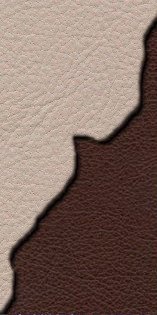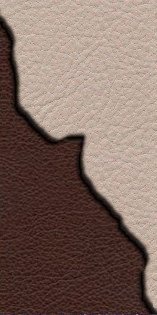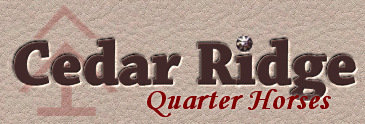

HERDA, GBED, PSSM1, and MH
HERDA
![]() GBED
GBED
![]() PSSM1
PSSM1
![]() MH
MH
![]() Genetic Testing
Genetic Testing
A "Quick and Dirty Summary" of Some Genetic Concerns for Breeders
Hopefully, all breeders are learning to match their breeding stock to produce sound horses with correct legs and good dispositions. Matching bloodlines for performance abilities is not new. However, with advancement of scientific knowledge and DNA testing, more should now be done when choosing stallion/mare pairings.
For several years, genetic tests for defects such as HYPP and HERDA have been available to help Quarter Horse breeders choose breeding stock. A sudden flurry of testing for PSSM1 and GBED (and some for MH) began as diagnostic evaluation became available and knowledge of the tests spread.
Should you breed a horse that carries a genetic disease that can be tested via DNA? Until registration associations make rules governing this in their registry, that answer must come from breeders through their own practices. And breeders need to be informed in order to make good decisions.
Ideally, we would never breed a horse that doesn't have 100% correct legs. A perfect back. A beautiful head. A proven show record or work record on the ranch/trail.
But we all know that is not how it goes in the breeding barn or pasture. Should we knowingly breed horses that aren't perfect, like those examples? Now, we must also consider behind-the-scenes genetics that might have no affect on offspring, or that could cause abortion or death of offspring...and heartache for owners.
HERDA
 GBED
GBED
 PSSM1
PSSM1
 MH
MH
 Genetic Testing
Genetic Testing
 Back to Top
Back to Top
![]()
HERDA
From Wikipedia: Hereditary equine regional dermal asthenia (HERDA) aka hyperelastosis cutis (HC) is an inherited autosomal recessive connective tissue disorder. It develops from a homozygous recessive mutation that weakens collagen fibers that allow the skin of the animal to stay connected to the rest of the animal. Affected horses have extremely fragile skin that tears easily and exhibits impaired healing. In horses with HC, the skin separates between the deep and superficial dermis. There is no cure. Most individuals receive an injury they cannot heal, and are euthanized.
Managed breeding strategy is currently the only option for reducing the incidence of the disease.
-
Heterozygous carriers are not affected (-/+ or N/Hrd) by the disease.
-
95% of affected horses trace back to Poco Bueno on both sides of their pedigrees.
-
To prevent it from occurring, the only solution is not to cross two horses who both carry the HERDA allele.
-
Complete eradication in a breed could be achieved if breed associations require testing and if they do not allow carriers to produce registered offspring.
| PROs for Breeding a Carrier | CONs for Breeding a Carrier |
| The gene pool of the breed remains large, and highly successful mares and stallions will be able to pass along their performance ability to produce offspring with excellent performance potential. | Breeding a carrier to another carrier offers a 25% chance of an offspring that will most likely need to be euthanized by age 4. |
| It is safe to breed carriers to non-carriers in that resulting foals will not be affected. | Breeding a carrier to an untested horse could result in an offspring affected, which would most likely need to be euthanized by age 4. |
| If breeders are not honest or don't test their horses and breed appropriately, affected foals could result. | |
| As long as carriers are bred, the defect will continue to be found in the breed. |
HERDA
 GBED
GBED
 PSSM1
PSSM1
 MH
MH
 Genetic Testing
Genetic Testing
 Back to Top
Back to Top
![]()
GBED
From Wikipedia: Glycogen Branching Enzyme Disorder occurs in foals who are homozygous for the lethal GBED allele, meaning both parents must be heterozygous for the allele (i.e. the parents must both be carriers...if one or both parents are not carriers, their foals will not be affected). Most foals with GBED are aborted or stillborn, and those that survive live only for a few months. This genetic disease has been linked to the foundation Quarter Horse sire King P-234.
Managed breeding strategy is currently the only option for reducing the incidence of the disease. Using DNA test results, breeders can avoid crosses that could produce GBED foals, and eventually selectively breed it out. Initial samples suggest that about 10% of Quarter Horses are carriers.
-
Heterozygous carriers are not affected (-/+ or N/Gb) by the disease.
-
GBED has been linked to King P-234
-
To prevent affected foals from occurring, the only solution is not to breed two horses if they both carry the GBED allele.
-
Breeding a non-carrier to another non-carrier will result in 100% non-carrier foals.
-
Permanent eradication in a breed could be achieved if breed associations require testing and if they do not allow carriers to produce registered offspring.
| PROs for Breeding a Carrier | CONs for Breeding a Carrier |
| The gene pool of the breed remains large, and excellent stallions/mares will have unaffected offspring if they are not bred to another carrier. | Carriers should ONLY be bred to DNA tested non-carriers. Breeding a carrier to another carrier offers a 25% chance of an offspring that will not live. |
| It is safe to breed carriers to non-carriers. Resulting foals will not be affected. | If breeders are not honest or don't test their horses and breed appropriately, affected foals could result. |
| As long as carriers are bred, the defect will continue to be found in the breed. |
HERDA
 GBED
GBED
 PSSM1
PSSM1
 MH
MH
 Genetic Testing
Genetic Testing
 Back to Top
Back to Top
![]()
PSSM1
From Wikipedia: EPSM or Equine Polysaccharide Storage Myopathy is a muscle disease most commonly associated with heavy horse breeds. Common heavy horse breeds in the United States include the Clydesdale, Shire, Belgian Draft or Belgian, Suffolk Punch and Percheron. EPSM may also occur in the American Quarter Horse and other light horse breeds or draft mules and horses that have draft lineage. The Quarter Horse community calls the condition PSSM (Polysaccharide Storage Myopathy). EPSM may, less commonly, be found in most other breeds including Standardbred, Arab and Thoroughbred.
Managed breeding strategy is currently the only option for reducing the incidence of the disease.
-
PSSM1 is a dominant trait, and all carriers will be affected in some way. Update 2/24/2012: I will try to find the source. Today I read that only 5% of carriers are affected noticeably, and 95% very minimal or not affected. I will attempt to learn whether this is true, and will update the page.
-
Some carriers are mildly affected, and may rarely have an incidence of issue.
-
Other carriers may be severely affected without proper dietary and exercise management.
-
A much higher percentage of Quarter Horses with halter breeding carry PSSM than the incidence in performance bloodlines.
-
Because it is a dominant trait, the only way to prevent affected offspring is to not breed carriers at all. Most people believe this to be true...use them for riding, but not for breeding.
-
Permanent eradication in a breed could be achieved if breed associations require testing and if they do not allow carriers to produce registered offspring.
| PROs for Breeding a Carrier | CONs for Breeding a Carrier |
| The gene pool of the breed remains large. | Carriers will pass their PSSM1 gene to offspring 50% of the time, and each offspring receiving this gene will be affected. |
| Homozygous carriers will pass their PSSM1 gene to offspring 100% of the time. | |
| Symptoms can be lessened/managed with diet, but riding/using a PSSM1 horse is not as easy as enjoying a non-carrier. | |
| Horses that are carriers and therefore affected may be "dumped" at horse sales to unsuspecting/uneducated buyers or to slaughter buyers. | |
| As long as carriers are bred, the defect will continue to be found in the breed. |
Many horses with this condition are happy trail horses, successful pleasure horses, and useful ranch horses. The greatest difficulty in owning a horse with PSSM is the time commitment to keep the horse fit and the moderate expense of special feeds (high fat, low starch diet). (http://www.cvm.umn.edu/umec/lab/PSSM/home.html)
HERDA
 GBED
GBED
 PSSM1
PSSM1
 MH
MH
 Genetic Testing
Genetic Testing
 Back to Top
Back to Top
![]()
MH
From
Equinenews.com: Malignant hyperthermia (MH) is a genetic disorder of
horses suggested to be an autosomal dominant trait. MH is confined to
Quarter Horses and members of related breeds such as Appaloosas and Paints.
Less than 1% of Quarter Horses are affected, and those that are seem to
trace to two specific bloodlines (not yet
announced as of February, 2012). Mature horses are
usually affected, and there does not seem to be a gender predilection.
Clinical signs of MH include high body temperature, either under general
anesthesia or in conjunction with an episode of tying-up, usually type 1
polysaccharide storage myopathy (PSSM).
Managed breeding strategy is currently the only option for reducing the incidence of the disease.
-
Often coexists with PSSM1
-
Merck Veterinary Manual lists MH as being a recessive gene (heterozygous carriers are not affected, but will pass their defective gene to offspring ~50% of the time). Wikipedia lists it as a dominant trait (carriers would be affected).
| PROs for Breeding a Carrier | CONs for Breeding a Carrier |
| The gene pool of the breed remains large. | Carriers will pass their MH gene to offspring 50% of the time. |
| MH can cause sudden death, usually during a procedure requiring anesthetic. | |
| Horses that are carriers may be "dumped" at horse sales to unsuspecting/uneducated buyers or to slaughter buyers. | |
| As long as carriers are bred, the defect will continue to be found in the breed. |
HERDA
 GBED
GBED
 PSSM1
PSSM1
 MH
MH
 Genetic Testing
Genetic Testing
 Back to Top
Back to Top
![]()
Genetic Testing
-
University of California at Davis: http://www.vgl.ucdavis.edu/services/horse.php
-
University of Minnesota: http://www.vdl.umn.edu/ourservices/equineneuromuscular/home.html
-
Animal Genetics, Inc. http://www.horsetesting.com/Equine.asp
![]()
Links
-
AQHA Rulebook for 2012 section regarding genetic defects: click here
-
http://www.equinechronicle.com/health/genetic-diseases-in-quarter-horses-and-related-breeds.html
This page last updated
08/10/20
If you notice this date being 2 years or older, please let
us know that we need to check out this page!


Home Horses For Sale Stallions Mares Foals Blog Color Genetics Riding Horses Site Map Contact Us

Toni Perdew
Bedford, Iowa
toni@grullablue.com
712-370-0851 cell, before 9 p.m. CST
![]()
www.facebook.com/CedarRidgeQuarterHorses
Web design by
CR
Equine Sites.
All rights reserved. Graphics are watermarked for copyright protection.
Terms of Use
